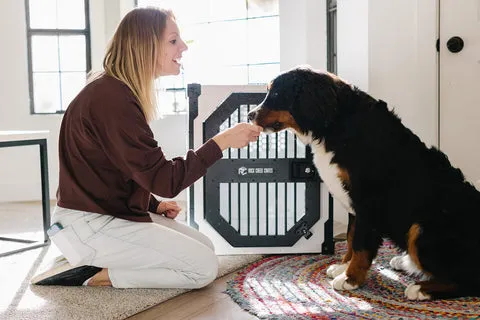Knowing How Long Can A Dog Stay In The Crate is essential for ensuring this space remains a happy, safe, and relaxing spot for your canine companion. Dogs naturally seek out den-like spaces, but a crate should never feel like unwilling confinement. The ideal crating duration depends heavily on your dog’s age, individual needs, and how regularly they receive mental and physical stimulation outside the crate. Understanding these factors is key to successful crate training and maintaining your dog’s well-being. Additionally, mastering commands like how to train a dog to come here can improve your overall control and communication with your pet, contributing to a more balanced life both inside and outside the crate.
Puppy Crate Time: The Age-Based Rule
Before delving into exercise routines and your dog’s unique temperament, it’s vital to grasp the basic guidelines for crating. A general rule of thumb, as recommended by the Humane Society of Western Montana, suggests taking your puppy’s age in months, adding one, and that figure represents their maximum crate hours before they require a potty and exercise break. For instance, a 2-month-old puppy should manage about 3 hours in their crate, a 3-month-old puppy around 4 hours, and so on, until they reach approximately 7 or 8 months of age.
Generally, adult dogs should not be kept in a crate without a break for periods exceeding a maximum of 8 to 9 hours. Leaving your dog crated for overly extended periods can unfortunately lead to them developing depression, anxiety, and even form permanent negative associations with their crate, according to Reader’s Digest. Pet parents invest considerable effort into building positive feelings around the crate, and it’s crucial not to undermine this hard work by routinely leaving a dog crated for too long, thus preserving the many benefits a crate provides.
 A dog resting comfortably inside a spacious crate
A dog resting comfortably inside a spacious crate
Boost Crate Comfort with Mental & Physical Exercise
If your schedule occasionally requires your dog to be crated for longer durations, providing adequate mental and physical stimulation becomes even more critical. Daily Paws highlights that sufficiently exercising your dog, both physically and mentally, helps them to expend excess energy, enabling them to remain content and rest comfortably in their crate for longer periods. Incorporating various activities before or after extended crate time can make a significant difference.
Here are a few practical ideas for easy mental and physical stimulation:
- Puzzle Toys: Toys that conceal special treats, compelling your dog to work for their reward, are excellent for stimulating and rewarding your pet. They encourage your dog to use their sense of smell to sniff out goodies while engaging their problem-solving skills to retrieve the treats. Some puzzle toys are compact and crate-friendly, offering an ideal solution for keeping your dog occupied if you need to crate them while you’re at work and have limited time for a long walk.
- A Good Walk: The most effective way to stimulate your dog before crate time is, undeniably, a good walk. Walking allows them to move their bodies, utilize their noses, and absorb their surroundings, providing a comprehensive sensory workout. By the time they return home, they are often quite ready to settle down and rest after such an enriching experience. Training your dog not to pull on its leash can make these walks even more enjoyable and effective.
- Interactive Play: On days when the weather is poor or your schedule is tight, interactive play serves as an excellent method to stimulate your dog before crating. A lively game of tug in the living room, a few rounds of fetch in the backyard, or a trick training session with ample rewards can engage your dog in all the right ways, preparing them for a period of rest. This also applies to preventing unwanted behaviors like how to stop a dog jumping on sofa by providing appropriate outlets for their energy.
 A dog playing with a puzzle toy to get treats, demonstrating mental stimulation
A dog playing with a puzzle toy to get treats, demonstrating mental stimulation
Dog Personality Plays a Role in Crate Duration
While 8 to 9 hours generally represents the maximum recommended crating time for an adult or near-adult dog, not all dogs will have the same personal tolerance. “Lazier” dog breeds, such as a Bulldog or a Bernese Mountain Dog, might be perfectly content spending a 9-hour workday in their crate. Some may even tolerate additional crate time, provided they receive regular potty and exercise breaks between stays.
Conversely, higher-energy breeds, like a Border Collie or a Belgian Malinois, are more likely to prefer shorter crate stays and typically require more significant periods of stimulation to remain happy. When determining how long can a dog stay in the crate, your individual dog’s personality and energy levels will be a crucial factor. What works for one dog might not be suitable for another, highlighting the need for a personalized approach to crating. For instance, a high-energy puppy might need specific training like how to train a puppy to come on command to manage their activity levels.
 A border collie energetically playing fetch, illustrating physical exercise for a high-energy breed
A border collie energetically playing fetch, illustrating physical exercise for a high-energy breed
Whether you need to crate your dog for a couple of hours while running errands or for a full 8-hour workday, having the right crate is always paramount. A well-chosen crate, combined with patient and consistent crate training, offers your dog a secure, comfortable, and safe personal space, regardless of where their day takes them. Proper training ensures they do not develop behavioral issues, such as trying to dart out the door when opportunities arise.
